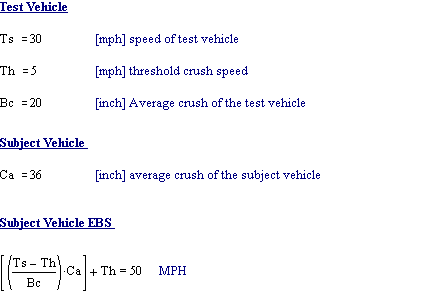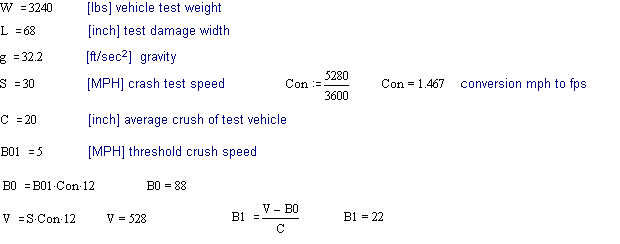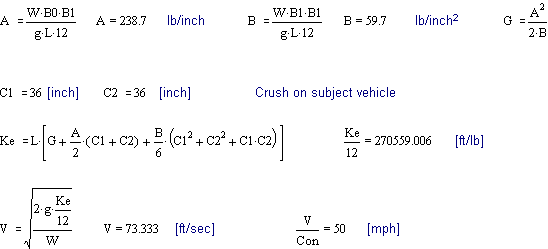
The Traffic Accident Reconstruction Origin -Article-
|

|
[Home]
[ARnews]
[Contents]
[Classified]
[Advertisers]
[Approach Angles]
[E-mail Directory]
[Feedback]
[Organizations]
[Reference Library]
This is a solution to the "Speed Estimate from Crush" question. These methods can be
found in numerous publications including NUTI Topic Book #870 "Work, Energy and Speed
from Damage in Traffic Accidents", SAE Paper #910119 "Stiffness Parameters
for Vehicle Collision Analysis from Crash Test(s) for Crash Data" and in the SLAM Technical
Manual.
The information offered in the original problem that was utilized in this analysis
is repeated below:
- Both the test vehicle and the subject vehicle were 1984 Ford Mustangs.
- The weight of both vehicles was 3240 lbs.
- The test vehicle and the subject vehicle were both crushed across the entire 68
inch wide fronts surfaces.
- The test vehicle's average crush depth was 20 inches at a speed of 30 MPH. Coincidentally,
This is a ratio of 1.5 MPH per inch of crush, which is an old rule of thumb
equation.
- The subject vehicle's average crush depth was 36 inches. Using the rule of thumb
equation mentioned above we end up with 36 x 1.5 = 54 MPH. Using two well known sets of
equations/methods let's see how close that rule of thumb actually is.
Approach #1
The first method has been around as long as the CRASH computer program:

Approach #2
The second method calls for the determination of crush coefficients, which will
be used in quantifying Kinetic Energy dissipation.


Both approaches agree yielding speed estimates of 50 M/H. It appears that the rule of thumb
estimate of 54 M/H was also a fair estimate.
The problem statement conditions of a stopped bus, no rebound and a final velocity of
0 M/H renders this case as a rare example where closing speed, Delta V and Eqivalent
Barrier Speed all have the same value.
J. F. (Jim) Mitchell is an independent accident reconstructionist, author (International Guide Book for Traffic
Accident Reconstruction) and computer software programmer who resides in Barrie, Ontario, Canada. Jim
retired from the Canadian Military Police in 1990 after 25 years service and then put in three years as an
accident reconstructionist with the Special Investigations Unit of the Attorney General of Ontario. Jim has
been ACTAR certified since 1994. He can be reached at
jfmitch@sympatico.ca.
[Home Site]
[ARnews]
[Contents]
[Classified]
[Advertisers]
[Approach Angles]
[E-mail Phone Book]
[Feedback]
[Organizations]
[Reference Library]






